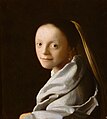Tronie

A tronie or tronje ( Dutch for 'head', 'face' or 'facial expression') is a genre of representational painting. These are portrait-like head and character studies, in which anonymous people with interesting physiognomy or costumes are often depicted, sometimes with literary or allegorical meaning.
In the 16th century, painters practiced tronies, which they painted from living models in order to prepare the figures for large historical paintings. In the course of the 17th century, these facial studies established themselves as an independent art form. Many artists created collections of character heads as preliminary studies for paintings, especially for history painting . The making of "tronies" is particularly widespread in the workshops of Dutch painters of the 17th century and developed into an independent art form around Rembrandt . There was a lucrative market in the Netherlands for tronies, which were at times very popular with art collectors.
The man with the gold helmet , around 1650, 67.5 × 56.7 cm
Jacob Jordaens , Apostle, 1623/25, 68.5 × 51.5 cm
Peter Paul Rubens , head study, around 1630
Jan Vermeer , Young Girl, around 1665/67, 44.5 × 40 cm
literature
- Franziska Gottwald: The Tronie. Pattern - study - masterpiece. The genesis of a genre of painting from the 15th century to Rembrandt . Deutscher Kunstverlag, Munich / Berlin 2011. ISBN 978-3-422-06930-5
- Franziska Gottwald: Heads of Christ in the Context of the Tronie. In: Rembrandt and the Face of Jesus. Yale University Press, New Haven / London 2011. pp. 147-159. ISBN 978-0-300-16957-7
- Dagmar Hirschfelder: Tronie and Portrait in Dutch Painting of the 17th Century . Gebr. Mann, Berlin 2008. ISBN 978-3-7861-2567-9
- Dagmar Hirschfelder, León Krempel: Tronies. The face in the early modern era. Mann, Berlin 2014. ISBN 978-3-7861-2694-2
- León Krempel: Sappho's look over his shoulder. In: Tronies. Marlene Dumas and the old masters. Richter, Düsseldorf 2010, ISBN 978-3-941263-20-8 , pp. 10-27.
Individual evidence
- ↑ Hans-Joachim Raupp (Ed.): Portraits. Dutch painting in the SØR Rusche collection. LIT Verlag, Münster / Hamburg / London 1995, ISBN 3-8258-2204-4 , p. 13 f. (on-line)
- ^ Klaus Grimberg: Rembrandt's Laboratory. The three sides of the Dutch master. ( Memento of the original from February 3, 2014 in the Internet Archive ) Info: The archive link was inserted automatically and has not yet been checked. Please check the original and archive link according to the instructions and then remove this notice. In: The Atlantic Times. August 2006, retrieved from the atlantic-times.com portal . on February 2, 2014.



